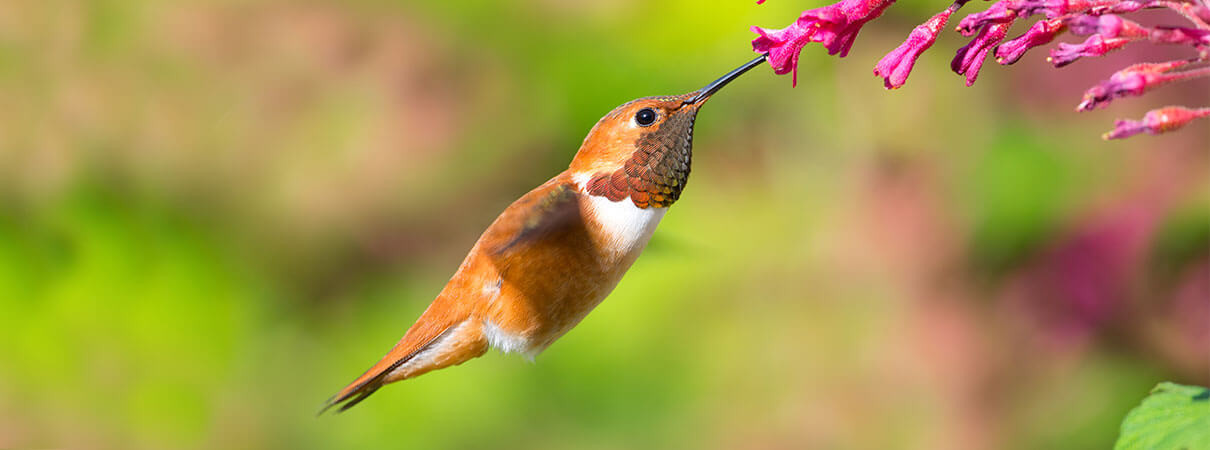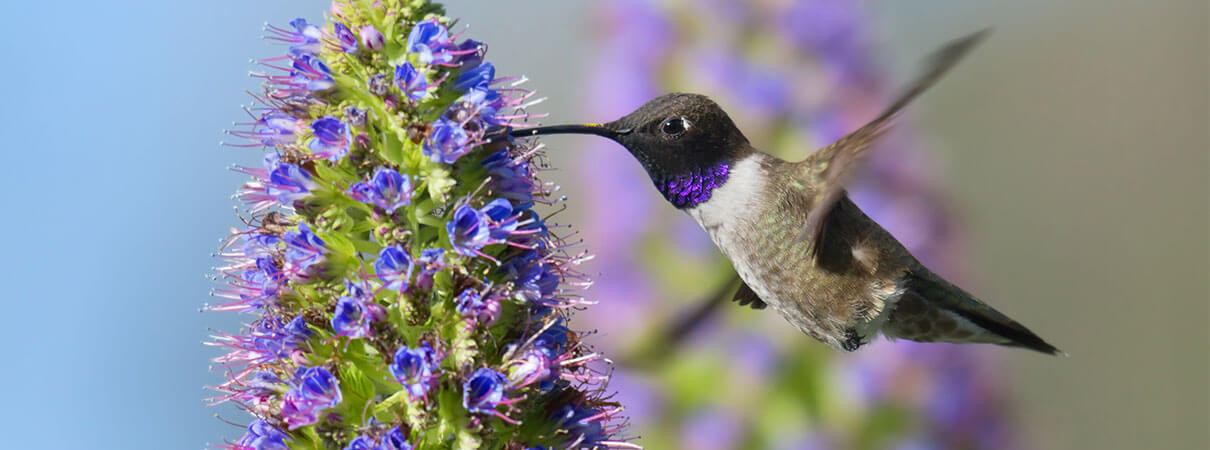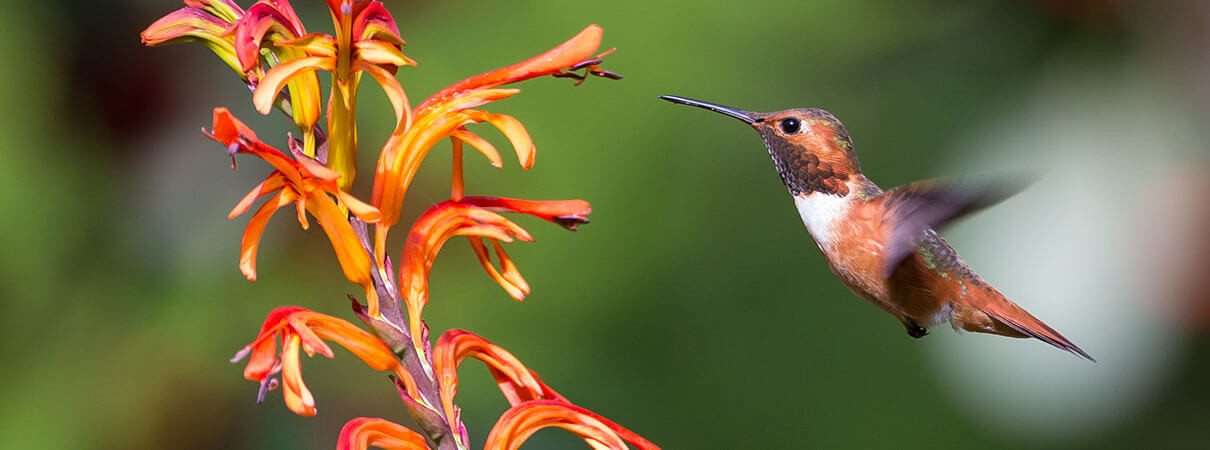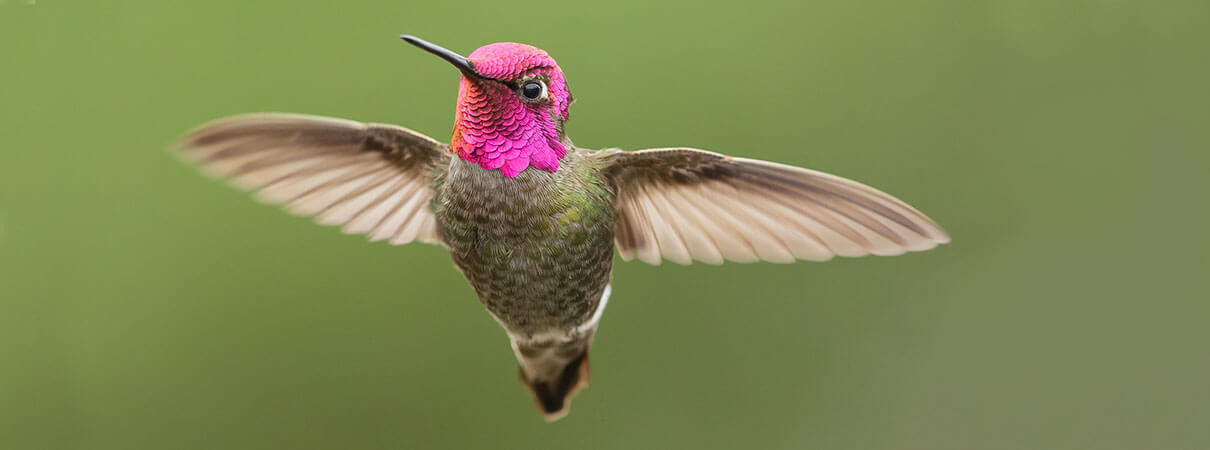Do Hummingbirds Fly South For Winter? Yes, most North American hummingbirds migrate south to Mexico and Central America for the winter in search of food sources. Flyermedia.net provides a wealth of information on avian migration and aviation insights. Understanding hummingbird migration patterns can help aviation enthusiasts and bird lovers alike appreciate the complexity of nature. Discover more about these fascinating journeys and aviation-related content on flyermedia.net, exploring similar patterns in migratory birds.
1. Why Do Hummingbirds Migrate South for the Winter Season?
Hummingbirds migrate south for the winter to find food sources like flowers and insects. During late summer and fall, they embark on these journeys, influenced more by decreasing daylight hours than immediate hunger or falling temperatures. This ensures they have access to the resources they need to survive.
1.1. What Drives the Start of the Hummingbird Migration?
Decreasing daylight hours is the primary trigger for hummingbirds to begin their migration. This is a biological cue that signals the change in seasons and the impending scarcity of food. This instinctual response ensures they arrive in warmer climates with abundant resources.
1.2. What Types of Food Sources do Hummingbirds Seek in Warmer Climates?
In warmer climates, hummingbirds seek nectar from flowers and small insects. These food sources are crucial for their high metabolism and energy requirements. The availability of these resources in the southern regions sustains them throughout the winter.
2. Where Do Hummingbirds Migrate to During the Winter Months?
Most North American hummingbirds migrate to Mexico or Central America for the winter. These destinations provide warmer temperatures and abundant food sources necessary for their survival. Some species may also overwinter in the southern United States along the Atlantic and Gulf Coasts.
2.1. Why Are Mexico and Central America Popular Destinations for Hummingbirds?
Mexico and Central America offer ideal wintering conditions for hummingbirds due to their consistent warm temperatures and plentiful flowering plants. These regions provide a stable food supply, allowing hummingbirds to thrive during the colder months in North America.
2.2. How Far Can a Hummingbird Fly During Its Migration?
The distance a hummingbird can fly during its migration varies by species. For example, the Ruby-throated Hummingbird can make the 500-mile journey across the Gulf of Mexico in less than a day. The Rufous Hummingbird undertakes a 3,900-mile journey, showcasing the incredible endurance of these tiny birds.
3. What are the Migration Patterns of Common North American Hummingbirds?
Several common North American hummingbirds exhibit distinct migration patterns. These include the Ruby-throated Hummingbird, Rufous Hummingbird, Black-chinned Hummingbird, and Allen’s Hummingbird. Each species has unique timing and destinations for their migratory journeys.
3.1. What is Unique About the Ruby-throated Hummingbird’s Migration?
The Ruby-throated Hummingbird migrates from its breeding grounds in the U.S. and southern Canada to southern Mexico and Central America. Some individuals remain in the southern United States. This species showcases a strong ability to adapt to different environments and food sources.
 Ruby-throated Hummingbirds Hummingbirds do migrate. Photo by Sari Oneal/Shutterstock.
Ruby-throated Hummingbirds Hummingbirds do migrate. Photo by Sari Oneal/Shutterstock.
The photo features Ruby-throated Hummingbirds in flight, highlighting their migratory nature and aerial agility.
3.2. How Does the Rufous Hummingbird’s Migration Stand Out?
The Rufous Hummingbird’s migration is notable for its length and circular route. They travel 3,900 miles from their wintering grounds in Mexico to breeding grounds in Washington State and Canada, then back south through the Rocky Mountains. This journey is one of the longest relative to their size in the bird world.
 Rufous Hummingbirds migrate to southern Mexico and Central. Photo by Birdiegal/Shutterstock.
Rufous Hummingbirds migrate to southern Mexico and Central. Photo by Birdiegal/Shutterstock.
This image captures the Rufous Hummingbird, emphasizing its long migratory journey from Mexico to Canada.
3.3. What is the Migration Behavior of the Black-chinned Hummingbird?
The Black-chinned Hummingbird occupies a large portion of the western United States during summer. After breeding, they move to higher elevations before heading to western Mexico or the Gulf Coast for the winter. This species is known for its adaptability to various habitats, including urban areas.
 Black-chinned Hummingbird. Photo by sumikphoto/Shutterstock.
Black-chinned Hummingbird. Photo by sumikphoto/Shutterstock.
The photograph depicts a Black-chinned Hummingbird, illustrating its adaptable nature to diverse habitats.
3.4. Where Does the Allen’s Hummingbird Migrate?
Allen’s Hummingbirds migrate from their wintering grounds in early December to the coasts of California and Oregon by January. One subspecies migrates to central Mexico, while the other stays in southern California. Their early arrival allows them to take advantage of winter wildflowers.
 Allen
Allen
The image showcases an Allen’s Hummingbird, highlighting its early migration to California and Oregon.
4. Which Hummingbird Species Do Not Migrate?
Anna’s Hummingbird is a notable exception to the general migration pattern of North American hummingbirds. They typically do not migrate, although they may move short distances in search of additional food sources.
4.1. Why Doesn’t Anna’s Hummingbird Migrate?
Anna’s Hummingbird does not migrate because it has adapted to year-round food availability in its habitat. The introduction of exotic flowering trees and the popularity of backyard hummingbird feeders have provided consistent nectar supplies, eliminating the need for long-distance migration.
4.2. Where Can You Find Anna’s Hummingbird?
Anna’s Hummingbirds can be found along the Pacific Coast, from northern Mexico to southern Canada. Their range has expanded due to the availability of food sources, making them a resident species in these areas.
 Anna
Anna
The photograph features Anna’s Hummingbird, showcasing its non-migratory nature and adaptation to year-round habitats.
5. How Do Hummingbirds Prepare for Migration?
Hummingbirds prepare for migration by increasing their body fat to fuel their long journeys. They also adjust their feeding patterns to maximize energy intake. This preparation is crucial for their survival during migration.
5.1. How Do Hummingbirds Build Up Energy Reserves Before Migration?
Hummingbirds build up energy reserves by consuming large amounts of nectar and insects. This hyperphagia, or increased eating, allows them to store fat, which they use as fuel during migration. They can double their body weight in fat before starting their journey.
5.2. Do Hummingbirds Change Their Feeding Habits Before Migrating?
Yes, hummingbirds change their feeding habits before migrating. They focus on high-calorie food sources and increase their feeding frequency. This ensures they have enough energy to sustain themselves during the long flights to their wintering grounds.
6. What Challenges Do Hummingbirds Face During Migration?
Hummingbirds face numerous challenges during migration, including habitat loss, predation, and weather conditions. These factors can significantly impact their survival and migration success.
6.1. How Does Habitat Loss Affect Hummingbird Migration?
Habitat loss reduces the availability of food sources and resting places along migration routes. This makes it harder for hummingbirds to find the resources they need, increasing their stress and mortality rates. Conservation efforts are essential to protect these crucial habitats.
6.2. What Predators Do Hummingbirds Encounter During Migration?
Hummingbirds face predation from various animals, including birds of prey, spiders, and even praying mantises. These predators can pose a significant threat, especially during migration when hummingbirds are more vulnerable.
6.3. How Do Weather Conditions Impact Hummingbird Migration?
Adverse weather conditions, such as strong winds, storms, and cold temperatures, can make migration more challenging for hummingbirds. These conditions can deplete their energy reserves and increase the risk of mortality.
7. What Conservation Efforts Are in Place to Protect Hummingbirds?
Several conservation efforts are in place to protect hummingbirds, including habitat preservation, creation of bird-friendly gardens, and advocacy for bird-friendly policies. These efforts aim to ensure the survival and well-being of hummingbird populations.
7.1. How Can Creating Bird-Friendly Gardens Help Hummingbirds?
Creating bird-friendly gardens provides hummingbirds with essential food sources and habitats. Planting native flowering plants that provide nectar, offering clean water sources, and avoiding pesticide use can all contribute to a healthy environment for hummingbirds.
7.2. What Role Do Policies Play in Hummingbird Conservation?
Policies enacted by Congress and federal agencies, such as the U.S. Fish and Wildlife Service, play a crucial role in hummingbird conservation. These policies can protect habitats, regulate pesticide use, and promote bird-friendly practices. Advocating for these policies is essential for hummingbird conservation. You can help shape these rules for the better by telling lawmakers to prioritize birds, bird habitat, and bird-friendly measures. To get started, visit ABC’s Action Center.
7.3. How Does Habitat Preservation Support Hummingbird Populations?
Habitat preservation ensures that hummingbirds have access to the resources they need to survive. Protecting natural areas from development, restoring degraded habitats, and managing existing habitats in a bird-friendly way can all support hummingbird populations.
 Anna
Anna
This image depicts Anna’s Hummingbird, emphasizing the importance of habitat preservation for their survival.
8. How Can You Help Hummingbirds During Their Migration?
You can help hummingbirds during their migration by providing food, water, and shelter in your backyard. Planting native flowering plants, setting up hummingbird feeders, and avoiding pesticide use can all support these tiny travelers.
8.1. How Can You Provide Food for Migrating Hummingbirds?
You can provide food for migrating hummingbirds by planting native flowering plants that provide nectar. You can also set up hummingbird feeders with a sugar-water solution. It is important to clean and refill feeders regularly to prevent the growth of harmful bacteria.
8.2. How Can You Offer Water to Migrating Hummingbirds?
You can offer water to migrating hummingbirds by providing a shallow dish of clean water or a birdbath. Ensure the water is fresh and clean, and that the dish is shallow enough for hummingbirds to access it safely.
8.3. How Can You Provide Shelter for Migrating Hummingbirds?
You can provide shelter for migrating hummingbirds by planting trees and shrubs in your yard. These plants offer protection from predators and harsh weather conditions. You can also create brush piles or leave dead trees standing to provide additional shelter.
9. What is the Impact of Climate Change on Hummingbird Migration?
Climate change can significantly impact hummingbird migration patterns by altering flowering times, shifting habitats, and increasing the frequency of extreme weather events. These changes can disrupt the timing of migration and reduce the availability of food sources.
9.1. How Does Climate Change Affect Flowering Times?
Climate change can cause flowering plants to bloom earlier or later than usual, disrupting the synchrony between hummingbird migration and food availability. This can make it harder for hummingbirds to find the resources they need, reducing their survival rates.
9.2. How Does Climate Change Shift Hummingbird Habitats?
Climate change can cause hummingbird habitats to shift as temperatures and precipitation patterns change. This can force hummingbirds to move to new areas in search of suitable conditions, which can be challenging if they are unable to adapt quickly enough.
9.3. How Do Extreme Weather Events Impact Hummingbird Migration?
Extreme weather events, such as droughts, floods, and storms, can devastate hummingbird habitats and disrupt migration patterns. These events can reduce the availability of food sources and increase the risk of mortality.
10. What are Some Interesting Facts About Hummingbird Migration?
Hummingbird migration is full of interesting facts, such as their ability to fly long distances relative to their size, their high metabolism, and their unique feeding behaviors. Learning about these facts can deepen your appreciation for these amazing birds.
10.1. How Far Can a Hummingbird Fly Relative to Its Size?
Hummingbirds can fly incredibly long distances relative to their size. The Rufous Hummingbird, for example, travels 3,900 miles during its migration, which is roughly equal to 78.4 million body lengths. This is one of the longest migratory journeys in the bird world relative to body size.
10.2. How Does a Hummingbird’s Metabolism Affect Its Migration?
Hummingbirds have the highest metabolism of any warm-blooded animal. This high metabolism requires them to consume large amounts of food to fuel their flight. During migration, they must balance energy expenditure with energy intake to survive.
10.3. How Do Hummingbirds Navigate During Migration?
Hummingbirds use a combination of visual cues, magnetic fields, and innate instincts to navigate during migration. They may follow familiar landmarks, use the position of the sun, or sense the Earth’s magnetic field to stay on course. Further research is ongoing to fully understand their navigation strategies.
Understanding the intricacies of hummingbird migration reveals a fascinating aspect of avian life. For aviation enthusiasts, the parallels between these natural journeys and the world of flight are captivating. Just as hummingbirds navigate vast distances, pilots rely on skill and technology to traverse the skies. Flyermedia.net offers a range of resources for those interested in aviation and the natural world, providing insights into flight training, aviation news, and career opportunities. Whether you’re drawn to the skies or the wonders of nature, explore flyermedia.net to discover more. Address: 600 S Clyde Morris Blvd, Daytona Beach, FL 32114, United States. Phone: +1 (386) 226-6000. Website: flyermedia.net.
FAQ: Hummingbird Migration
1. Do all hummingbirds migrate?
No, not all hummingbirds migrate. Anna’s Hummingbird, for example, is a resident species that does not typically migrate.
2. Where do hummingbirds go in the winter?
Most North American hummingbirds migrate to Mexico and Central America for the winter.
3. How far do hummingbirds migrate?
The distance hummingbirds migrate varies by species. The Rufous Hummingbird travels 3,900 miles, while the Ruby-throated Hummingbird can cross the Gulf of Mexico in a single flight.
4. When do hummingbirds start their migration?
Hummingbirds typically begin their migration in late summer and early fall, triggered by decreasing daylight hours.
5. How do hummingbirds prepare for migration?
Hummingbirds prepare for migration by increasing their body fat and adjusting their feeding patterns to maximize energy intake.
6. What challenges do hummingbirds face during migration?
Hummingbirds face challenges such as habitat loss, predation, and adverse weather conditions during migration.
7. How can I help hummingbirds during migration?
You can help hummingbirds by providing food, water, and shelter in your backyard, planting native flowering plants, and avoiding pesticide use.
8. What is the impact of climate change on hummingbird migration?
Climate change can disrupt hummingbird migration by altering flowering times, shifting habitats, and increasing the frequency of extreme weather events.
9. How do hummingbirds navigate during migration?
Hummingbirds use a combination of visual cues, magnetic fields, and innate instincts to navigate during migration.
10. Are hummingbird populations increasing or decreasing?
Population trends vary by species. Some species, like the Ruby-throated and Black-chinned Hummingbirds, are increasing, while others, like Allen’s Hummingbird, are declining.